Shishi-Odoshi: Creating Your Own Japanese Bamboo Fountain for Your Garden
There’s a moment—and you’ll know it when it happens—when the hollow thunk of bamboo hitting stone cuts through the afternoon quiet. Not harsh, but deliberate. Not random, but rhythmic. It’s the sound of time itself being marked, each knock a gentle reminder to stop scrolling, stop planning, stop doing for just a second and actually be where you are. That’s the moment you realize a shishi-odoshi isn’t just a water feature. It’s a meditation you can build with your own two hands.

I remember the first time I heard one. Not in some pristine Kyoto garden, but in my neighbor’s chaotic backyard in suburban Ohio, wedged between a propane grill and a kids’ swing set. It shouldn’t have worked there. But it did. That sound—so ancient, so out of place—somehow made the ordinary extraordinary. And I stood there, clutching my watering can like an idiot, thinking: I need that in my life.
The Soul of the Shishi-Odoshi: More Than Just a Bamboo Fountain

Let’s be honest. When you first see a Japanese bamboo fountain, you might think, “That’s it?” A piece of bamboo, a rock, some water. It looks almost too simple. But here’s what I mean: that simplicity is the whole point. It’s a visual haiku, stripping away everything non-essential until you’re left with pure experience.
The name itself tells the original story. Shishi-odoshi translates roughly to “deer scarer.” Japanese farmers invented these centuries ago to keep hungry deer from decimating their crops. The sound—part percussion, part alarm—would startle animals away. There’s something deliciously ironic about that origin, because now we build them precisely for the sound, not in spite of it. We’ve taken a tool of anxiety and turned it into an instrument of peace.
But here’s the thing most people miss: a shishi odoshi fountain isn’t just about the noise. It’s about the silence between the noises. The build-up. The anticipation. The water slowly filling the bamboo tube, the way it teeters on the brink, and then—thunk—the release. That cycle mirrors something fundamental in us. The inhale and exhale. The tension and release. It’s no coincidence that these features appear in zen gardens. They’re physical manifestations of a mental process.
The Wabi-Sabi of Water: Understanding Shishi Odoshi Aesthetic
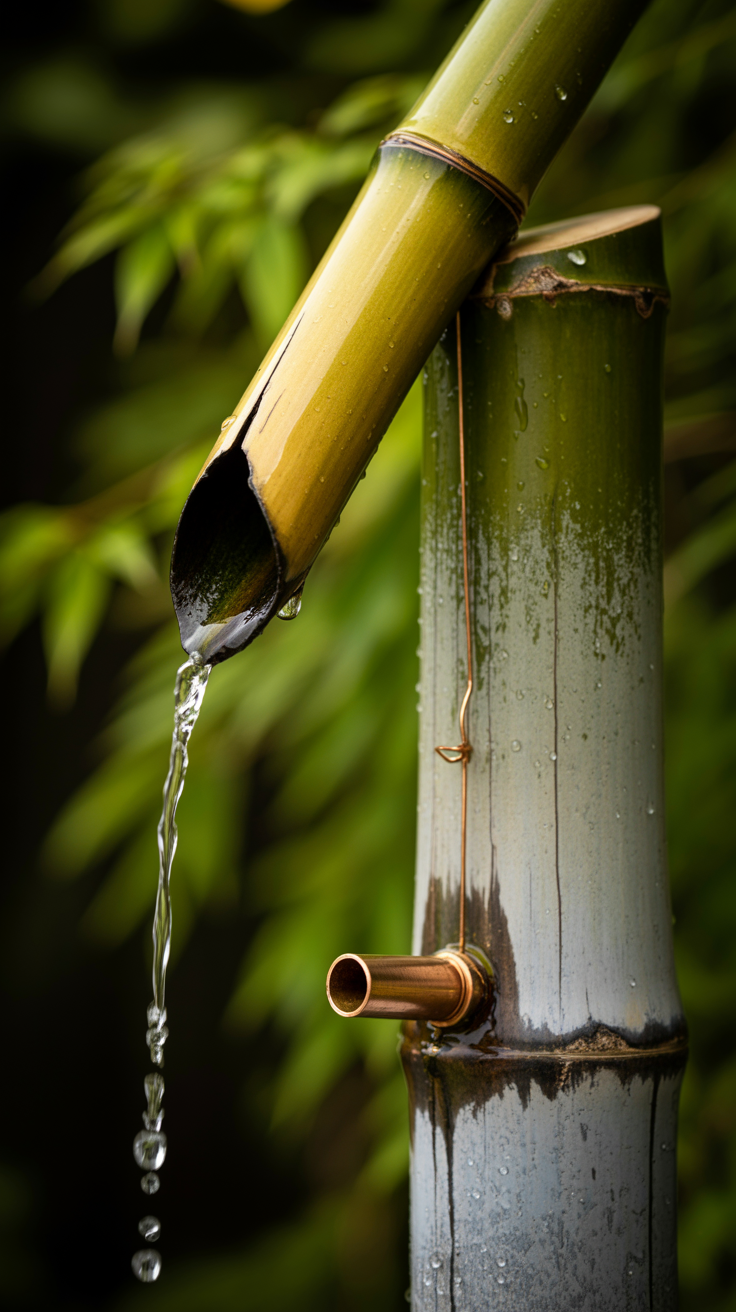
Before you run to the hardware store, let’s talk about the philosophy. Because building a shishi-odoshi fountain diy style without grasping the aesthetic is like learning guitar chords without ever listening to music. You can do it, but you’ll miss the soul.
The key concept here is wabi-sabi. And no, that’s not just a design buzzword—though it’s definitely been hijacked by Instagram influencers showing perfect pictures of imperfect things, which kind of misses the point entirely. Real wabi-sabi is about finding beauty in the authentic, the worn, the temporary. It’s why your shishi odoshi design should embrace bamboo with knots, slight discolorations, maybe even a small crack you stabilize rather than discard.
Think about it this way: a perfect, factory-made PVC pipe would function identically. But it would sound… dead. The shishi odoshi aesthetic demands natural materials because natural materials breathe. They change with humidity. They age. That gorgeous golden bamboo you install? In two years, it’ll be weathered to a silvery gray. And that transformation is part of the art. You’re not just building a fountain; you’re establishing a timeline.
And the sound itself—oh, the sound. A zen bamboo water fountain creates what I call “organized randomness.” The interval between thunks isn’t perfectly regular. Water pressure varies. Wind affects the pour. Your fountain will develop its own personality, its own slightly irregular rhythm. That’s not a flaw. That’s the difference between a machine and a living thing.
Choosing Your Bamboo: The Heart of Your Japanese Shishi Odoshi
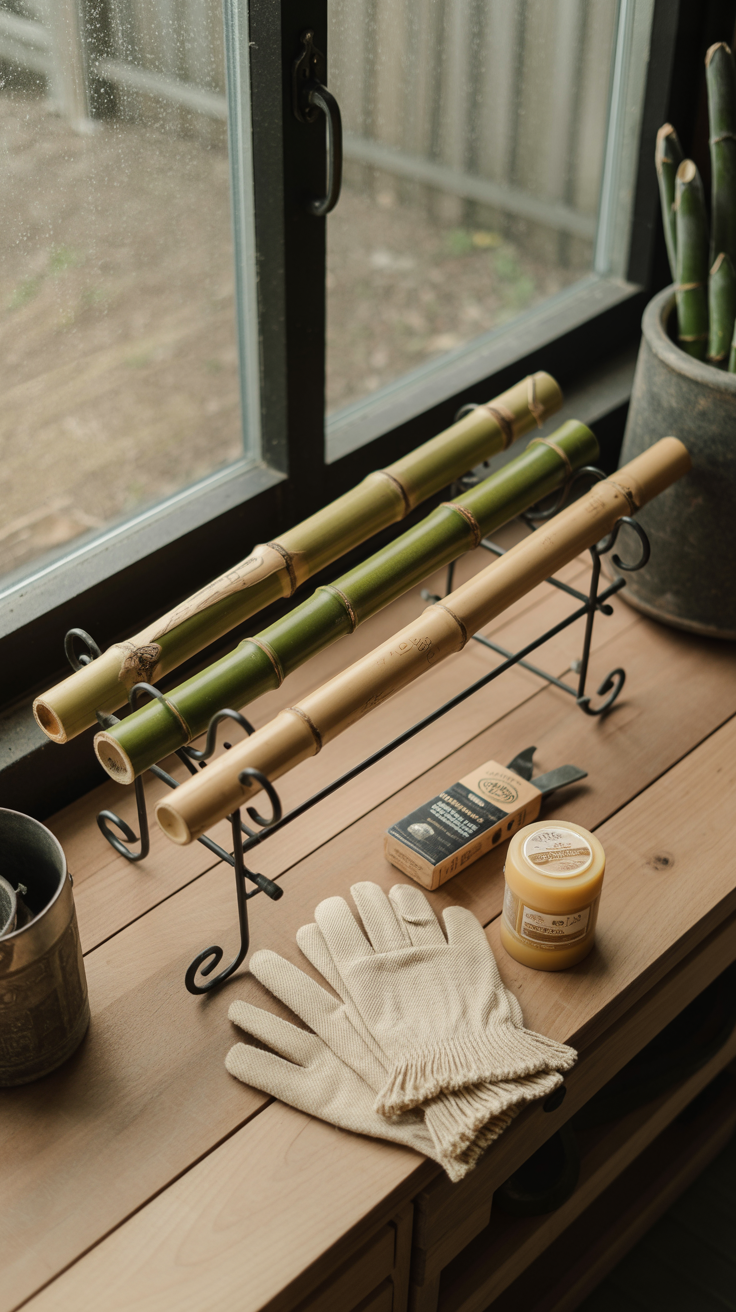
Okay, practical stuff. But I’ll level with you—this is where I almost gave up on my first shishi odoshi diy project. I walked into my local garden center, saw bamboo stakes for tomatoes, and thought, “Perfect!” Spoiler: they weren’t.
Traditional Japanese shishi odoshi uses madake bamboo—thick-walled, robust, with a diameter of 3-4 inches. It’s gorgeous. It’s also expensive and hard to find outside Japan. Here’s what I learned after three failed attempts: you need bamboo that’s been properly cured. Green bamboo is still alive, still full of sugars, and will crack within weeks. You want bamboo that’s aged at least six months, preferably a year.
If you’re lucky enough to have a bamboo nursery nearby, ask for “timber bamboo” poles. Moso bamboo works beautifully. You’re looking for a main spout piece about 4-5 feet long with a diameter of 3-4 inches. For the counterweight arm, you’ll want something slightly smaller—maybe 2-3 inches in diameter.
And here’s a detail that matters more than you’d think: the nodes. Those raised rings every foot or so? On your spout piece, you want one node at the very end that you keep intact—that’s what holds the water before it tips. On your counterweight arm, you’ll want a node near the center where you’ll drill your pivot hole. The denser fiber there prevents splitting.
I made the mistake of using a pole with a split node once. Filled it with water, and crack—the whole thing split lengthwise on day three. Honestly, it sounded like a gunshot. Scared the hell out of my cat. So check your bamboo carefully. Knock on it. It should sound solid, not hollow in a cheap way. And that brings us to design.
Mapping Your Shishi Odoshi Design: Measure Twice, Cut Once
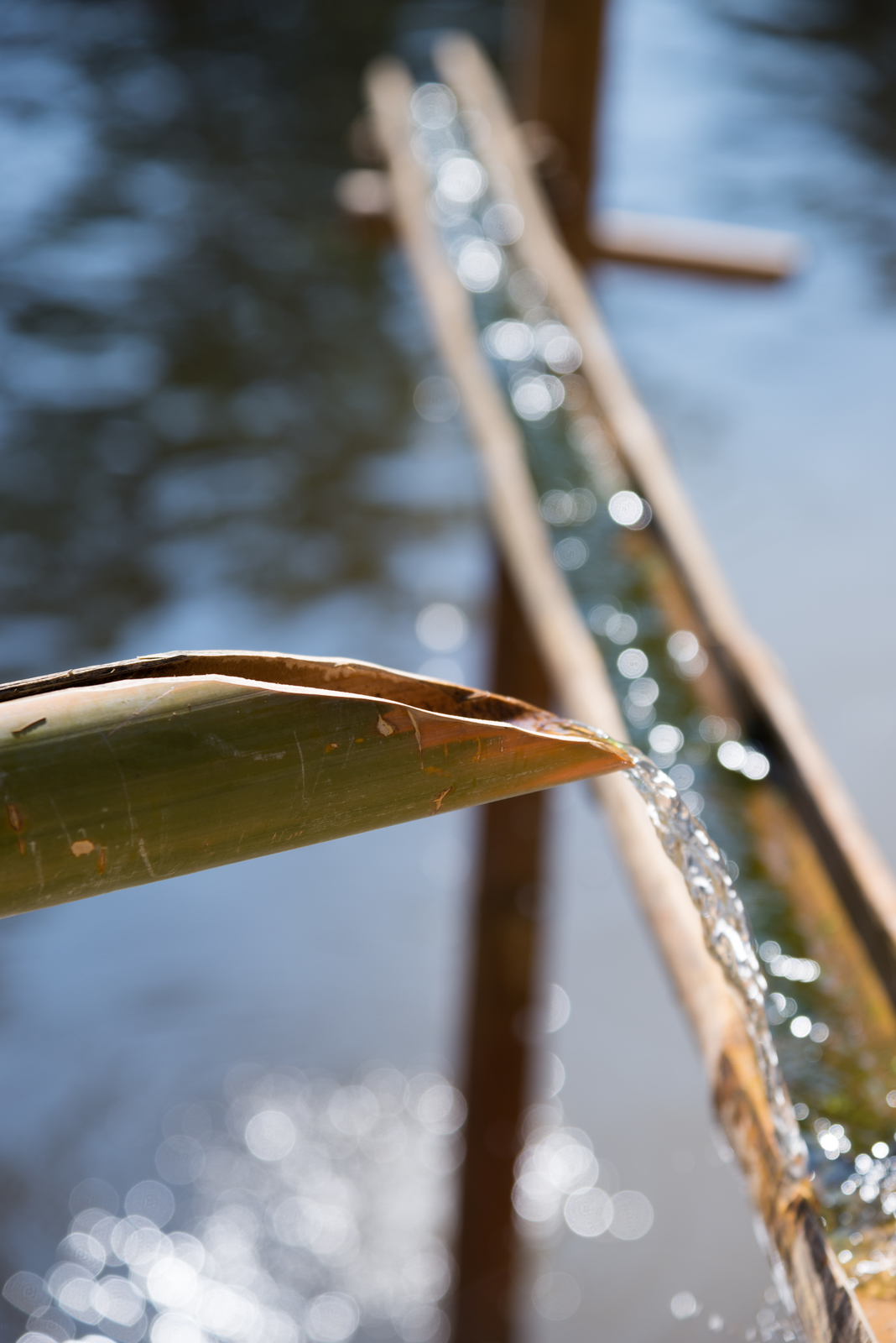
Here’s where we get a bit technical, but stick with me. A shishi-odoshi fountain operates on a simple lever principle. The water fills one end, becomes heavier than the counterweight, tips, empties, then the counterweight pulls it back. Simple physics. Except when it’s not.
The fulcrum—that point where your bamboo balances—is everything. Too close to the center, and the water never builds enough weight to tip. Too far, and it empties before making that satisfying thunk. The sweet spot is roughly 1/3 of the way from the counterweight end. But “roughly” is key. You’ll adjust.
For a standard design, here’s what worked for me:
- Main spout: 4 feet long, cut at a 45-degree angle at the open end. The angled cut creates that smooth pour of water.
- Counterweight arm: 2 feet long, with a solid node about 6 inches from the end.
- Fulcrum height: 18 inches off the ground. This gives the spout enough drop to hit your stone with authority.
Now, about that stone. The don piece, they call it. And it’s not just any rock. You want something with some mass—a piece of granite or basalt about 6-8 inches square. I found mine in a creek bed. My spouse thought I was insane hauling a 20-pound rock home “for ambiance.” But when that bamboo smacks solid stone versus, say, a piece of wood? The difference is night and day. Stone gives you a crisp, clear thock. Wood gives a disappointing thud.
Sketch it out. Don’t trust your mental math. I spent an afternoon with graph paper, a cup of coffee, and a growing sense of inadequacy before realizing I’d drawn my pivot point on the wrong side of the node. Again. Just draw it. You’ll thank me later.
Build Day: Your Bamboo Water Fountain DIY Journey Begins
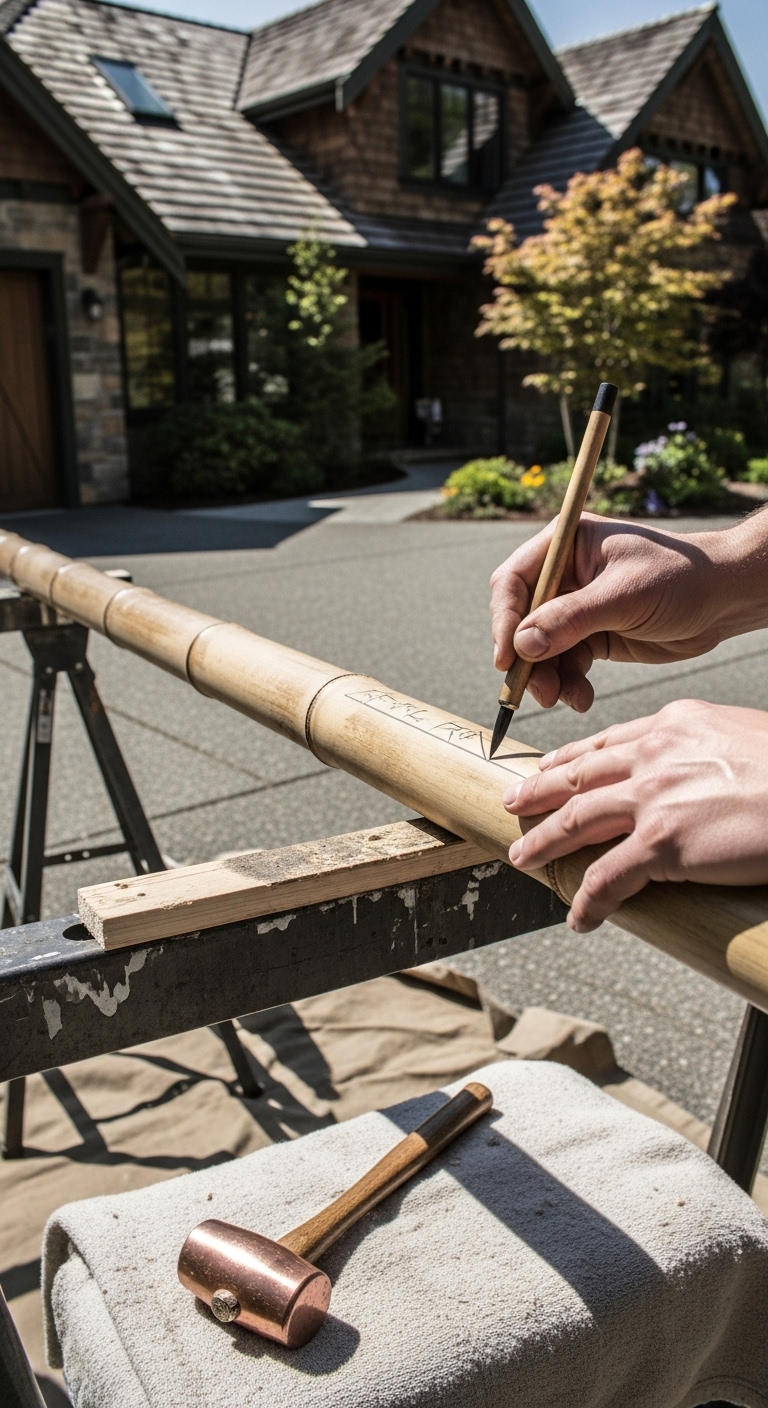
Alright. Deep breath. You’ve got your bamboo, your stone, your plans. Let’s build this thing. And I’m not going to lie to you—there’s a moment in every shishi odoshi fountain diy project where you think, “Why didn’t I just buy a pre-made one on Amazon?” Push through that. The pre-made ones sound like toys.
What You’ll Need
- Cured bamboo poles (main spout and counterweight arm)
- A sturdy rock for the base (don stone)
- Bamboo or wooden dowel for the pivot rod (about 1/2 inch diameter)
- Two support posts (bamboo or pressure-treated wood)
- Small water pump (80-120 GPH works perfect)
- Flexible tubing (1/2 inch)
- Waterproof basin or pond liner
- Drill with spade bits
- Handsaw or jigsaw
- Sandpaper
- Waterproof silicone sealant
- Level
Step 1: Prepare Your Bamboo
Measure and mark your cuts. Use masking tape around the cut line—this prevents splintering. Cut the spout at that crucial 45-degree angle. Now, here’s the part everyone skips: sand the inside of the spout opening. Just a little. You want the water to flow smoothly, not catch on rough fibers.
Drill your pivot holes. This is where I nearly lost a finger. Use a spade bit slightly larger than your pivot rod—you want some play, some wiggle room. For a 1/2-inch rod, use a 5/8-inch bit. Drill slowly. Bamboo loves to split if you rush. And drill through the node in your counterweight arm, not next to it. The node provides structural integrity.
Step 2: Build the Frame
Your two support posts go on either side of your fulcrum point, about 8 inches apart. They need to be rock solid. I set mine in concrete because I’m a bit obsessive, but you can use heavy metal stakes driven deep. The top of your supports should have notches cut to hold your pivot rod. Again, not a tight fit—you want the whole apparatus to rock freely.
Step 3: Assemble the Lever
Slide your pivot rod through one support, then through the counterweight arm, then through the main spout, then through the other support. The spout and counterweight arm should be able to move independently at first. You’ll connect them later.
Step 4: Create the Counterweight
Traditionally, you’d use a stone tied to the short arm. I use a bag of sand in a small canvas sack—it’s adjustable. Start with about 2-3 pounds. You can always add or remove.
Step 5: Connect and Balance
Here’s the fiddly part. You need to connect your spout and counterweight arm so they move as one unit, but you also need to adjust the balance. I use zip ties initially—crude but effective for testing. Slide the connection point along the spout until you find that magic spot where the empty spout tips back, but fills and tips forward with about 2 cups of water.
Test it manually first. Pour water in with a pitcher. Does it tip? Does it reset? Adjust. Adjust again. This might take an hour. Put on a podcast. Breathe.
The Plumbing: Making Your Shishi Odoshi Fountain Flow
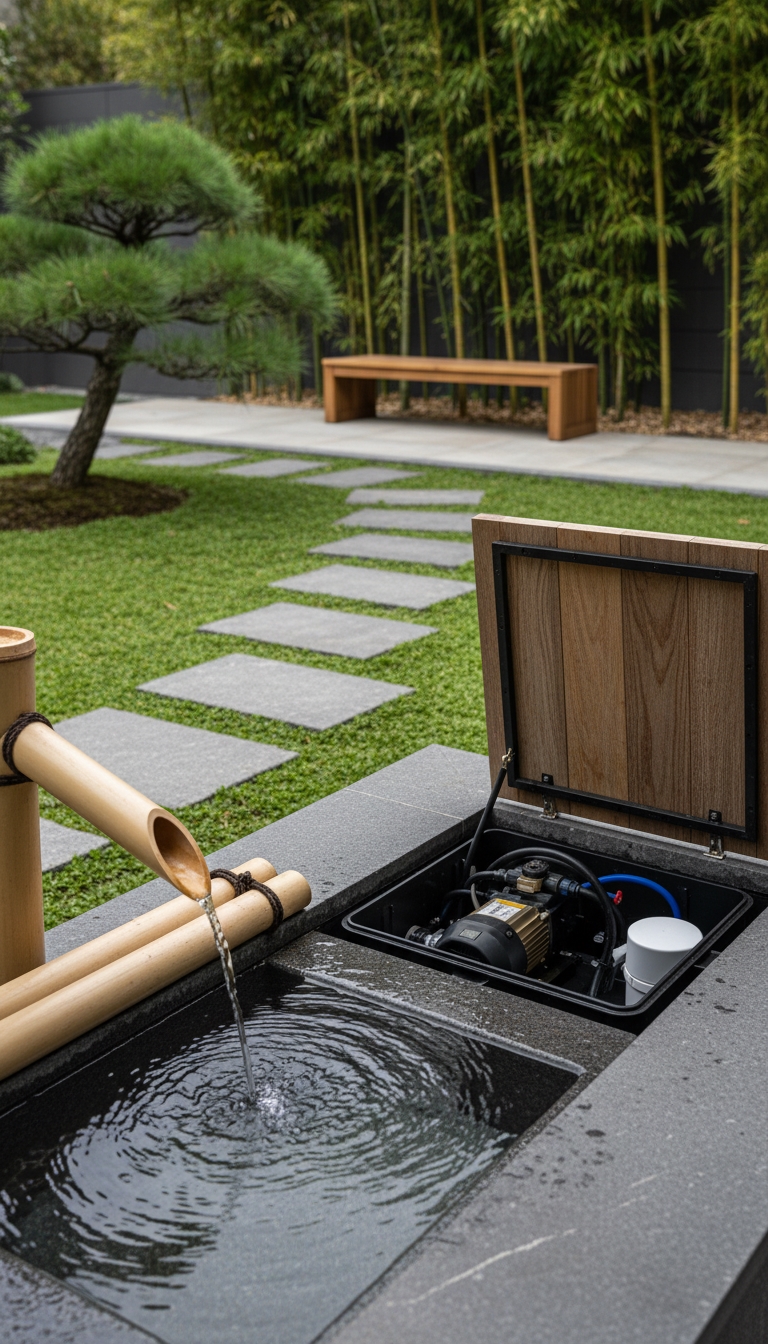
So you’ve got a tilting bamboo contraption that works when you pour water in. Great. Now we automate it.
Your water pump sits in a reservoir below. I use a 20-gallon rubber basin buried so the rim is just below ground level. You want the water to disappear after it flows, creating that endless cycle illusion.
The tubing runs from the pump up to your spout. Here’s my trick: drill a small hole in the upper side of your spout, about 6 inches from the pivot. Thread the tubing through, then run it along the inside of the bamboo to the tip. Secure it with a bit of silicone. This hides the modern stuff.
But—and this is crucial—don’t let the water pour directly from the tubing. The end of your tube should sit just inside the tip, not protrude. You want the water to flow from the bamboo, not from a plastic tube. It’s a subtle difference, but your ear will know.
Now, the sound of the water itself matters. A trickle sounds anemic. A gush sounds wasteful. You want a steady stream about the diameter of a pencil. Most pumps have a flow adjuster. Tinker with it. This is where your zen bamboo water fountain becomes truly yours.
Test everything. Turn it on. Walk away for ten minutes. Come back. Is the rhythm consistent? Does it reset properly? Mine needed three days of micro-adjustments before it found its groove. Be patient.
Beyond Tradition: Shishi Odoshi Modern Interpretations

Look, I’m a purist at heart. I love the traditional Japanese shishi odoshi aesthetic. But here’s what I’ve learned: the principle is timeless, the materials don’t have to be.
I’ve seen stunning modern versions. One friend used a sleek copper tube instead of bamboo—same mechanism, totally different vibe. The sound was sharper, more metallic, but still meditative. Another built a miniature version for her apartment balcony using PVC painted to look like bamboo (I know, I know, but she drilled micro-holes to soften the sound, and honestly? It worked).
The shishi odoshi modern movement is about adapting the concept to contemporary spaces. Maybe you don’t have a koi pond. Maybe you have a small courtyard with a recirculating fountain. Scale it down. Use a smaller tube, a lighter rock, a gentler pump. The physics remain the same.
I’ve even seen indoor shishi odoshi fountains built into large ceramic bowls, the water barely half a gallon total. The sound is intimate, close, like a heartbeat. That’s the thing about bamboo water fountain ideas—they’re endlessly adaptable. The core is that tipping motion, that rhythmic sound, that cycle of fill and release. Everything else is negotiable.
Integrating Your Shishi Odoshi Garden Feature
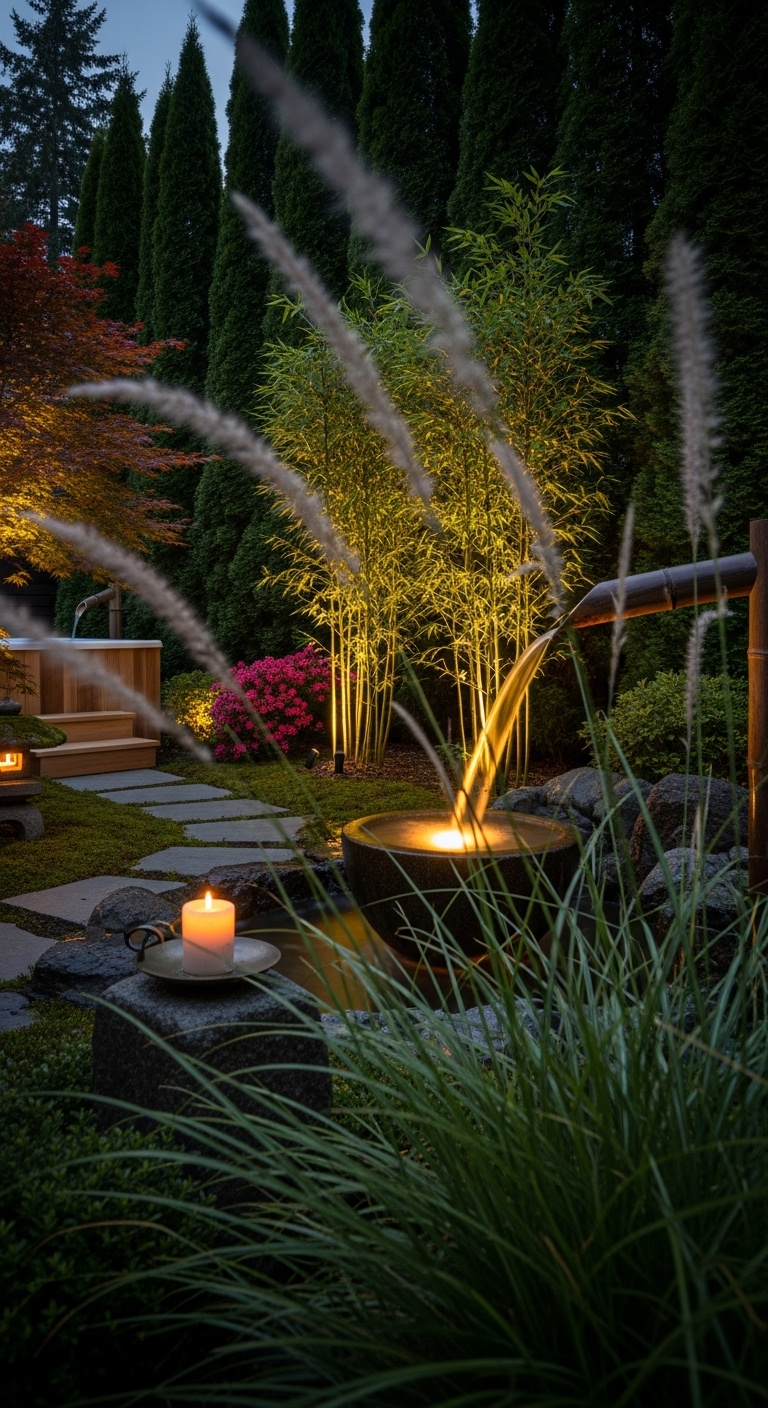
So you’ve built it. It works. Now where the hell do you put it?
Here’s where I made my biggest mistake. I placed my first one right outside my bedroom window because I loved the sound so much. Three nights of thunk… thunk… thunk at 2 AM, and I was ready to take an axe to the thing. So let’s talk placement.
The sound of a bamboo water fountain carries surprisingly far—about 30-40 feet in quiet conditions. You want it close enough to enjoy, but not so close it becomes sonic wallpaper. In Japanese gardens, shishi odoshi fountains are often partially hidden. You hear the sound before you see the source, which creates mystery, anticipation.
Consider the sight lines. Place it so the thunk happens just as you turn a corner, or as you’re looking at a particular plant. Frame it. My current one sits behind a clump of ornamental grass. You glimpse the movement through the blades, but the sound seems to come from everywhere.
Water source matters too. In a traditional shishi odoshi japanese gardens setting, it flows into a stone basin or a small pond. But I’ve seen gorgeous installations where the water disappears into a bed of river rocks, then recirculates from a hidden reservoir beneath. The visual of water vanishing adds to the magic.
Think about the seasons. Bamboo is remarkably resilient, but extreme cold will crack it. If you’re in a harsh winter climate, plan to either bring the spout indoors (just the spout—the frame can stay) or wrap it in burlap. I learned this the hard way when mine split during a polar vortex. The repair was… inelegant.
Maintenance: Keeping Your Bamboo Water Fountain Alive
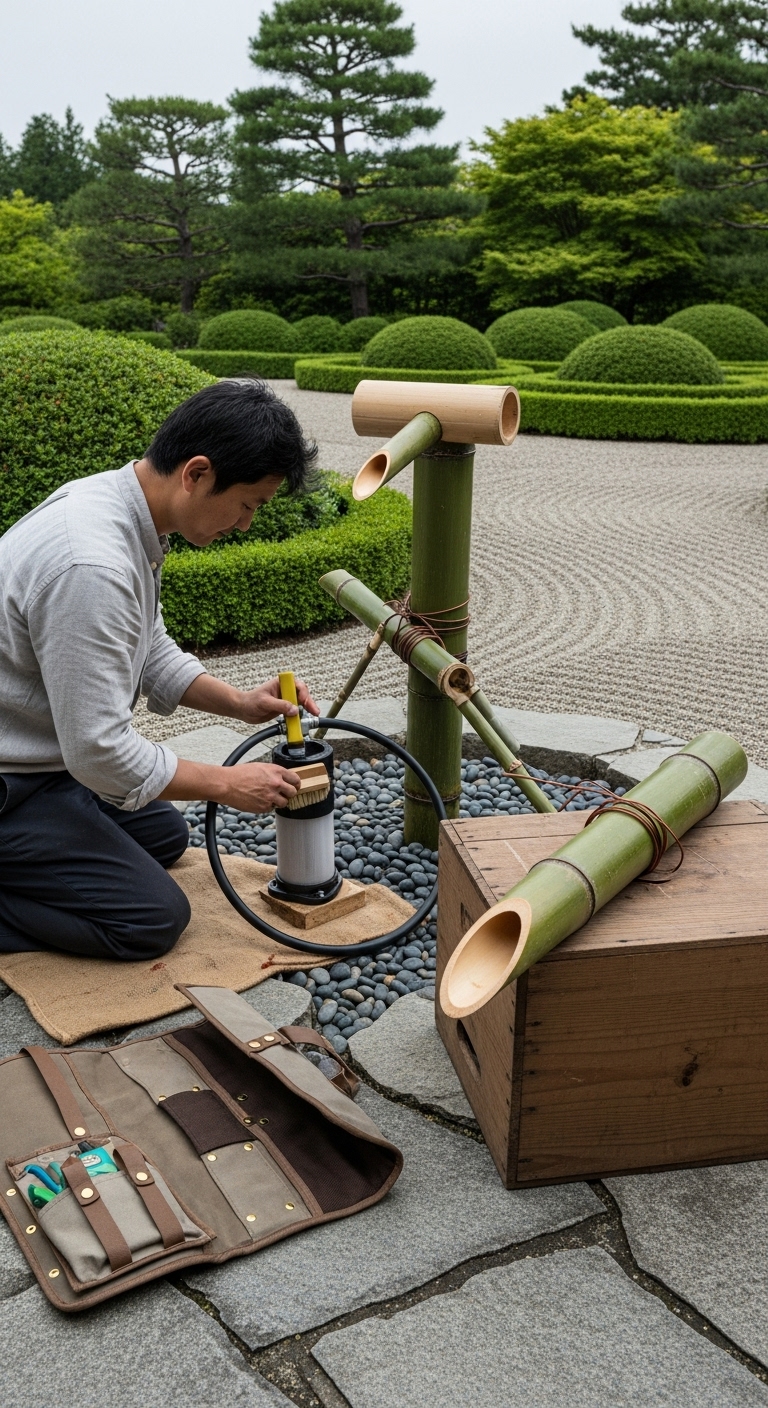
A shishi-odoshi garden feature isn’t high maintenance, but it’s not zero maintenance either. Treat it like a pet that doesn’t need feeding, just occasional attention.
Algae is your biggest enemy. That standing water in the reservoir? It’s a science experiment waiting to happen. I add a few drops of barley extract every month—natural, safe for any birds that might drink, and it keeps the water clear. A small UV clarifier in the pump line works too, but that’s more hardware.
Cracks happen. Bamboo dries, expands, contracts. Small surface cracks are fine—character, even. But if you get a split that affects function? You can wrap it with copper wire, or better yet, embrace the wabi-sabi and just replace that piece. I keep a spare spout piece cured and ready.
Pump cleaning is non-negotiable. Every month, pull it and clean the intake. Debris builds up, flow drops, and suddenly your perfect rhythm is… off. It’s a five-minute job. Do it while you’re deadheading flowers.
Winterizing: If you get real winters, drain everything. Store the pump indoors. Bring the spout and counterweight arm into your garage or basement. The supports and stone can stay. I wrap mine in a tarp, but that’s probably overkill. I’m just sentimental.
The Unspoken Reason: Why We Build These Things
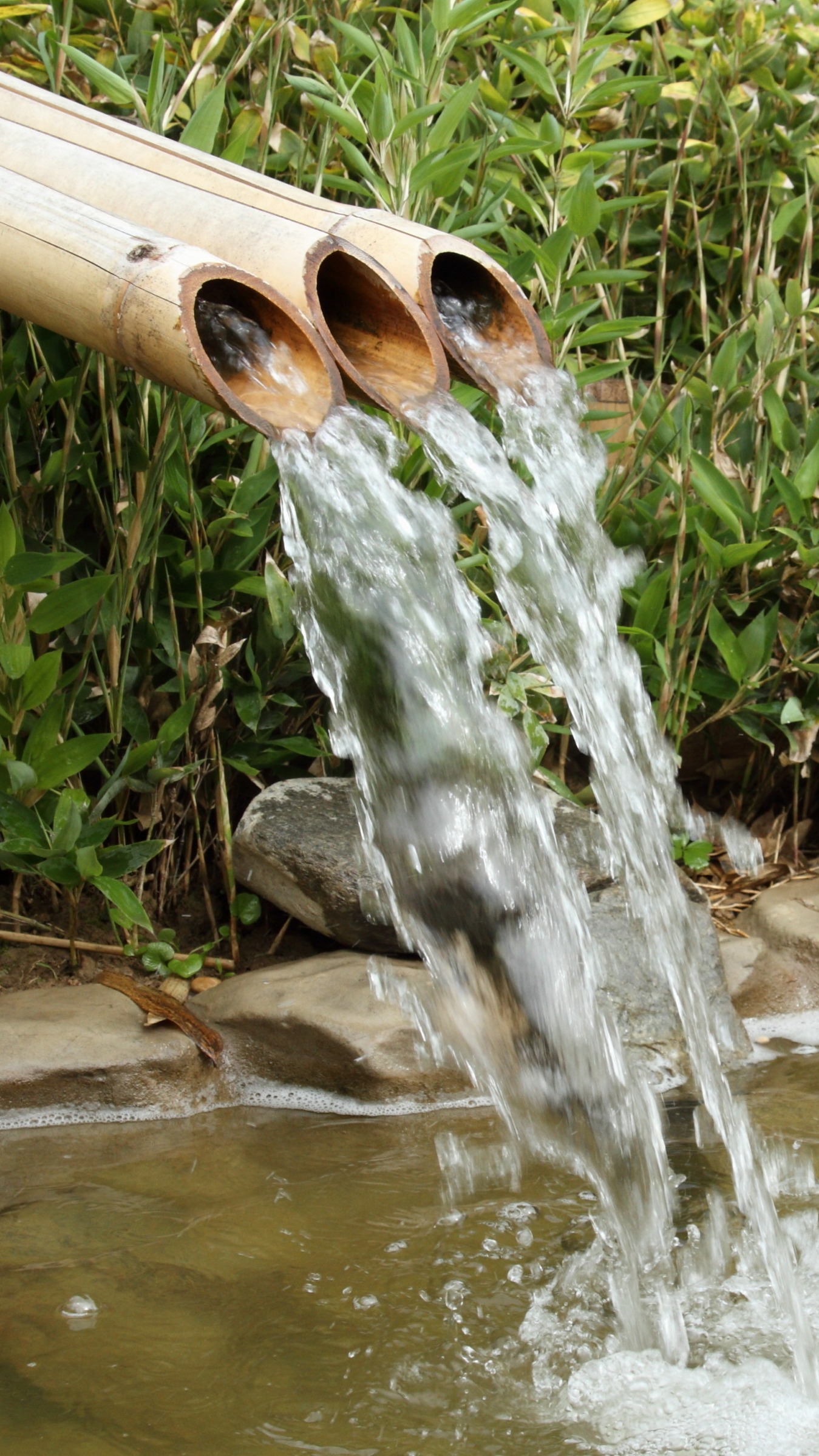
Here’s what the instruction manuals don’t tell you: building a shishi odoshi fountain diy is an act of faith in slow rewards.
We live in a world of instant everything. You can have a water feature delivered tomorrow with a remote control and LED lights. But a shishi-odoshi? You have to wait for the bamboo to cure. You have to adjust the balance, test the flow, listen, adjust again. It demands patience. And in that patience, something shifts.
I built mine during a particularly rough year. Work stress, family stuff, the whole messy human experience. And I’ll be honest—there were moments, standing in my backyard at dusk, adjusting that damn counterweight for the tenth time, when I thought, “What am I even doing?”
But then it worked. The first perfect thunk. And I sat there on the grass, dirty and tired, and just… listened. And the world narrowed to that sound, that cycle, that moment of release. The email I was stressing about? Gone. The conversation I was replaying? Silent. Just water, bamboo, stone.
That’s the gift. Not the Instagram-worthy photo (though you’ll take one). Not the compliments from neighbors (though you’ll get them). It’s the way a simple bamboo fountain can create a pocket of peace in a chaotic life.
Time to Create Your Own Shishi-Odoshi

So here’s my challenge to you: build one. Not because you need another project. Not because your garden is lacking. But because the act of creating something that measures time in water and sound will change how you experience your space.
Start small if you must. A tiny desktop version. A balcony setup. But start. Let yourself mess up. Let the bamboo crack and the balance be wrong and the pump be too loud. That’s all part of it. The shishi odoshi aesthetic isn’t about perfection—it’s about presence.
Your japanese bamboo fountain will become a barometer of your attention. On days you’re scattered, you’ll barely notice it. On days you’re present, you’ll hear every single thunk like a bell. And slowly, gradually, you’ll find yourself listening more. Not just to the fountain, but to everything else too. The birds. The wind. Your own breathing.
And maybe that’s the real point of these things. Not to scare deer, not to look authentic, not to check “Japanese garden feature” off your list. But to create a reason to stand still for sixty seconds and remember that you’re alive, right here, in this moment, with water flowing and bamboo knocking and time passing exactly as it should.
The instructions are above. The bamboo is waiting. That sound you need in your life? You’re the only one who can build it.
